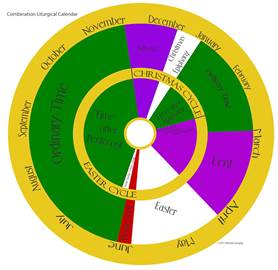
What is "Ordinary Time" in the Liturgical Calendar?

with permission from Michele Quigley
MicheleQuigley.com
The Liturgical Calendar dictates the rhythm of life for the Church. There are five Church seasons for the Roman Catholic Church: Advent, Christmas, Lent, the Paschal Triduum (a three-day season), and Easter, and there are two types of feasts: fixed and movable. Fixed feasts occur on the same calendar day every year, like the Feast of the Nativity of Christ (Christmas) on December the 25th. Movable feasts change every year; for example, Easter, the Feast of the Resurrection, takes place at a different date every year and sometimes a different month based on the first Sunday after the first full moon of the spring equinox. In addition, there are two blocks of "Ordinary Time."
The Sundays of the major seasons of the Liturgical Year are distinguished by their relationship to the Solemnities of Christmas (Advent and Christmas) and Easter (Lent and Easter). The other parts of the year, called Ordinary Time, refer to all the Sundays outside of the Christmas and Easter seasons which fall under the heading of celebrations of the "Day of the Lord." Ordinary time isn't a season; it is just a way to describe the weeks between the seasons. The word "ordinary" means regular or plain, but it also means "counted." Ordinal numbers are 1st, 2nd, 3rd, and so on; this is the meaning of "Ordinary Time" since we count the weeks between the Church's seasons in ordinal numbers.
The weeks of Ordinary Time number thirty-three or thirty-four depending on the year, and are divided into two parts of the liturgical year. The first part of Ordinary Time begins on the Sunday after Epiphany (although the first Sunday is perpetually impeded by the Feast of the Baptism of the Lord) and continues until Ash Wednesday. With the date of Easter varying every year, this first part of Ordinary Time may include as few as four weeks and as many as nine weeks. Part II of Ordinary Time begins the day after Pentecost and continues to the Saturday before the 1st Sunday of Advent.
Each year during Ordinary Time, we read through one of the Gospels. One year we read cycle A, which concentrates on readings from the Gospel of St. Matthew. The next year we turn to Cycle B, the focus of which is St. Mark's Gospel, and in the third year, we turn to readings from St. Luke's Gospel until we repeat the cycle. God's divine plan for mankind is revealed in the two Testaments and that is why we read and relive the events of salvation history contained in the Old and New Testaments, in the Church's Liturgy: "It is on this harmony of the two Testaments that the Paschal catechesis of the Lord is built, and then, that of the Apostles and the Fathers of the Church ..." (CCC 1094). The Church, in her wisdom, teaches that the Liturgy reveals the unfolding mystery of God's plan as we read the Old Testament in light of the New and the New Testament in light of the Old.
Michal Hunt, Copyright © 2015 Agape Bible Study. Permissions All Rights Reserved.